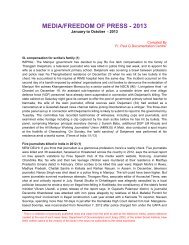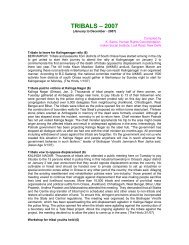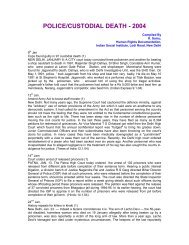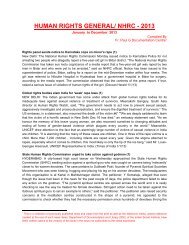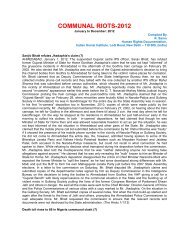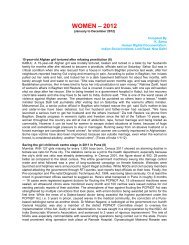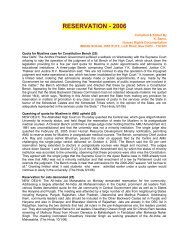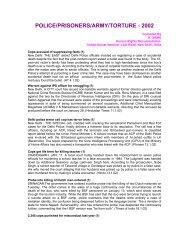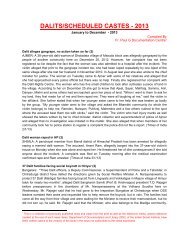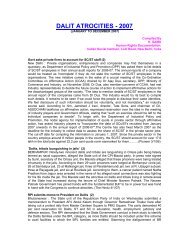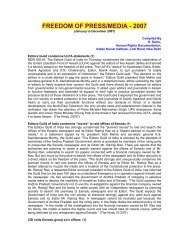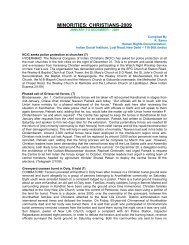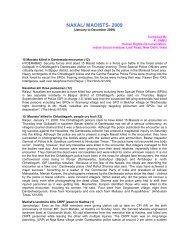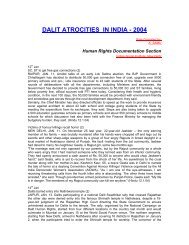You also want an ePaper? Increase the reach of your titles
YUMPU automatically turns print PDFs into web optimized ePapers that Google loves.
Nagaland and the adjoining state of Manipur, besides rebel leaders from groups like the Isak-Muivah<br />
faction of the (NSCN-IM) and the Naga National Council (NNC). "Unification of Naga dominated areas in<br />
the northeast is not a demand but a historical right of the people," Mani Charenamai, an MP from Manipur,<br />
said at the rally. Significantly, four Naga MLAs from Manipur also participated in the rally although a<br />
majority of the people in Manipur and the State Government have been vehemently opposing demands for<br />
unification. Rally organisers claimed hundreds of Naga tribal people from the adjoining states of Manipur,<br />
Assam, and Arunachal Pradesh attended the congregation. The rally assumes significance as peace talks<br />
with the NSCN(IM) has been deadlocked in recent months with New Delhi virtually rejecting the group's<br />
demand for unification. (Piioneer 1/9/05)<br />
4 meals a day Two is most they get (6)<br />
Dharni, Melghat (District Amravati), Sept. 1: Lack of employment during the monsoon months is one of the<br />
biggest causes of malnutrition among the tribals of Melghat region. This reporter ventured beyond Dharni,<br />
a taluka headquarters into the small hamlets in the interiors in Melghat, one of the most adverse and<br />
inhospitable regions in Maharashtra. As we made our way through lush greenery on one side and forests<br />
on the other side of the narrow road, we reached Bairagad, 37 km from here, with a population of over<br />
1,000. Dhansingh Vike, a local tribal said, "The employment guarantee schemes end with the summer in<br />
the month of May and the next three months are difficult to survive for us." He explained how it difficult it is<br />
to work in the fields during the agricultural harvest season. "Our bodies have to do the most strenuous<br />
work from dawn to sunset and we need more nutrition but cannot afford it due to poverty." The<br />
government has started various schemes so that tribals get nourishment during the monsoon months.<br />
These include the public distribution system (PDS) and the popular consumption loans scheme (CLS). But<br />
the tribals for whom this scheme is meant are harassed by PDS officials.Babu Kasdekar of Chatvabod<br />
said, "Many of us get ration cards only after our children are identified as malnourished. Even after getting<br />
the ration card, we find it difficult to purchase foodgrains as we cannot afford it." His neighbour Hiren said:<br />
"They are giving us rations which we should have got in May now, when we cannot afford it. If it was given<br />
in May, we could have purchased it and it would have saved our children." (Asian Age 2/9/05)<br />
Separate quota for tribals likely in Rajasthan (6)<br />
Jaipur : There is a move afoot to create a separate quota within the prescribed Scheduled Tribe<br />
reservation for some adivasi groups residing in the southern part of Rajasthan. Adivasis of Udaipur,<br />
Dungerpur, Banswara, Chittorgarh and Sirohi, constitute about 44 per cent of the total tribal population in<br />
the State. They are mostly from the Bheel, Grasia, Dholi, Dungary, Rawal, and Tadavi communities.<br />
Among other reasons, their weak economic status has ensured that their presence, despite the ST quota,<br />
in Government services is negligible. For the past several years, these tribals have been pressing for a<br />
separate quota within the ST quota so that they can avail job opportunities in the Government sector.<br />
According to well placed sources, the Government is considering constituting a committee of ministers to<br />
look into this demand. Minister of State for Tribal Area Development Kanakmal Katra for the past several<br />
months has been persuading the Government to focus attention on the tribals' demand. Currently, the<br />
influential tribal community of Meenas, mainly concentrated in the Sawai Madhpour and Karauli districts,<br />
hold a virtual monopoly in Government services under the 12 per cent reservation for STs. "This has to<br />
change and reservation benefits must be extended to other tribals of the State as well," Mr Katra says.<br />
Recently, the Gujjar community, currently listed in the Other Backward Classes category, organised a<br />
huge rally in the State capital to press for their demand that they be included in the ST category. To<br />
oppose this Gujjar demand, several Meena leaders, including some Ministers, met Chief Minister<br />
Vasundhara Raje last week. They say Gujjars cannot be considered STs because they have never<br />
resided in the forests like a true tribal community. Some Meena leaders are of the view that if Gujjars are<br />
included in the ST category, their present reservation quota under the OBC category be transferred to ST<br />
reservations. (Pioneer 6/9/05)<br />
'No starvation deaths among Sahariya tribals' (6)<br />
Jaipur : A Supreme Court fact-finding committee has concluded that there have been no starvation deaths<br />
among the Sahariya tribals in Barran district in Rajasthan as was being alleged by certain quarters. After<br />
touring 10 villages in the area, the six-member committee, appointed by the Supreme Court, said these<br />
deaths were taking place due to failure of the health system in this tribal-dominated district. About a<br />
fortnight ago, Pradesh Congress Committee general secretary Ashak Ali Tank, alleged that starvation



